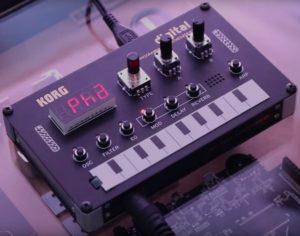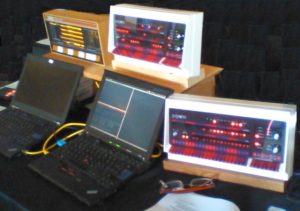I’ve been woodshedding an up-beat gospel tune, “Stop By, Lord” by Doris Wesley Bettis. It needs a brighter B3 registration than my typical church registrations. So, I turned to Genos™ for inspiration.
Two Genos voices stood out: GospelOrgan and UpsideDownSmile. They are similar and the drawbar settings form an arching curve (i.e., the upside down smile). Here are the registrations:
Genos GospelOrgan
16 5 1/3 8 4 2 2/3 2 1 3/5 1 1/3 1 Perc
---- ----- --- --- ----- --- ----- ----- --- ----
8 7 6 0 0 0 3 4 5 No
Genos UpsideDownSmile
16 5 1/3 8 4 2 2/3 2 1 3/5 1 1/3 1 Perc
---- ----- --- --- ----- --- ----- ----- --- ----
8 7 4 3 2 3 4 6 7 No
The UpsideDownSmile voice is at essence a brighter version of the GospelOrgan voice.
We need to translate the drawbar registrations (range [0:8]) into MODX Element levels (range [0:127]). The MODX factory patches use a range from 0 to 104. My own patches are using the range 0 to 127. Below is a table mapping each drawbar setting to the equivalent MODX Element level:
1 * 13 = 13 1 * 16 = 16
2 * 13 = 26 2 * 16 = 32
3 * 13 = 39 3 * 16 = 48
4 * 13 = 52 4 * 16 = 64
5 * 13 = 65 5 * 16 = 80
6 * 13 = 78 6 * 16 = 96
7 * 13 = 91 7 * 16 = 112
8 * 13 = 104 8 * 16 = 128
Take your pick: soft or hot.
I decided to implement each voice in its own MODX Part. Thus, we need to drop one of the drawbar harmonics in order to shoe horn the registration into eight Elements, the maximum number of individual elemental tones per Part. (Each Element is a drawbar footage.) A quick experiment on Genos found that I could drop the 2 2/3′ bar from the registrations without much sonic effect. It was pretty much buried in the harmonic mix.
The next table shows the Element levels for each MODX Performance.
Genos GospelOrgan
16 5 1/3 8 4 2 2/3 2 1 3/5 1 1/3 1
---- ----- --- --- ----- --- ----- ----- ---
104 91 78 0 0 0 39 52 65
127 112 96 0 0 0 48 64 80
Genos UpsideDownSmile
16 5 1/3 8 4 2 2/3 2 1 3/5 1 1/3 1
---- ----- --- --- ----- --- ----- ----- ---
104 91 52 39 26 39 52 78 91
127 112 64 48 32 48 64 96 112
The upper row in each case contains the Element levels over the range [0:104]. The lower row shows the Element levels over the range [0:127].
Starting with one of my church Performances, I created a three Part MODX Performance. There is one Part for the GospelOrgan setting and one Part for the UpsideDownSmile setting. The third part handles rotor noise, etc. I programmed two Scenes, one for each registration setting. Scene 1 mutes the UpsideDownSmile Part and Scene 2 mutes the GospelOrgan Part. Thus, I can switch between registrations by switching between Scenes. [In my next experiment, I’m going to try the SuperKnob to morph between registrations.]
Next up is the rotary speaker effect. Genos applies the REAL ROTARY effect:
USD Smile Gospel
--------- ------
Drive 2.5 4.0
Tone 8.5 10.0
Low/High Balance L<H1 L<H9
Output Level 100 100
Mic L-R Angle 180deg 120deg
Input Level +6dB +6dB
Modulation Intensity 63 63
Slow-Fast Time of Horn 1.13 1.13
Fast-Slow Time of Horn 0.97 0.97
Woofer Speed Slow 43.5 RPM 43.5 RPM
Horn Speed Slow 47.3 RPM 47.3 RPM
Woofer Speed Fast 403.7 RPM 403.7 RPM
Horn Speed Fast 464.3 RPM 464.3 RPM
REAL ROTARY is the “new” rotary speaker effect added in Montage. On MODX, this effect is called “Rotary Speaker 2”. The Tone parameter seems to function like a high-cut filter, BTW.
I prefer to slow the horn and rotor (woofer) down. Here is my LeslieChurch USER EFFECT preset on Genos:
Woofer Speed Slow 40.2 RPM 0.67Hz
Horn Speed Slow 48.0 RPM 0.80Hz
Woofer Speed Fast 343.2 RPM 5.72Hz
Horn Speed Fast 403.8 RPM 6.73Hz
Slow-Fast Time of Woofer 47
Slow-Fast Time of Horn 20
Drive Low 17
Drive High 42
Low/High Balance L=H
EQ Low Frequency 100Hz
EQ Low Gain -2dB
EQ High Frequency 14kHz
EQ High Gain -12dB
Mic L-R Angle 162deg
When moving between MODX and Genos, be prepared to convert RPM to Hertz and vice versa! Divide RPMs by 60 to get Hertz.
To complete the picture, let’s take a look at the MODX Rotary Speaker 2 presets. The MODX (Montage) has five presets:
- Clean and Wide
- Vintage Mono
- Slow and Dirty
- Full Drive
- Broken Motors
The following table shows the parameter values for each preset.
Clean Vint Mono Slow Dirt Full Dr Broken
-------- --------- --------- ------- ------
Drive 0.0 1.9 4.6 10.0 1.9
Tone 6.0 4.4 5.4 8.0 7.5
Low/High Balance R=H R=H R7>H R=H R<H11
Output Level 111 111 111 111 111
Mic L-R Angle 180deg 0deg 90deg 120deg 180deg
Input Level +1.5dB +1.5dB +1.5dB +1.5dB +1.5dB
Modulation Intensity 63 20 25 19 63
Slow-Fast Time Horn 0.95 0.78 0.98 0.98 0.95
Fast-Slow Time Horn 0.92 0.78 0.92 0.92 0.92
Horn Speed Slow 42.3rpm 40.4 33.4 42.3 59.9
Horn Speed Fast 398.7rpm 403.7 398.7 398.7 270.0
Slow-Fast Time Woofer 1.22 1.43 1.38 1.21 1.33
Fast-Slow Time Woofer 1.86 1.78 1.87 1.87 2.00
Woofer Speed Slow 40.1rpm 39.4 30.6 40.1 22.7
Woofer Speed Fast 323.0rpm 338.1 323.0 323.0 254.9
If you have a Genos, you might want to give these a spin. As of Genos update v1.3, it isn’t possible to set the Slow-Fast and Fast-Slow times for the woofer. I hope that Yamaha fix this oversight.
With respect to the gospel organ Performance, I started with the “Clean and Wide” preset values, then dialed in a few tweaks.
Changing the effect algorithm affected the rotary speaker speed control routing. I needed to drop into the Part Common Mod/Control parameters to select the Mod Wheel source and to set its destination to “InsA SpdCtrl”. (Insert A is the rotary speaker effect algorithm.)
If you’re looking for a gospel organ sound on MODX (Montage), I hope this information will help you out.
Copyright © 2019 Paul J. Drongowski


